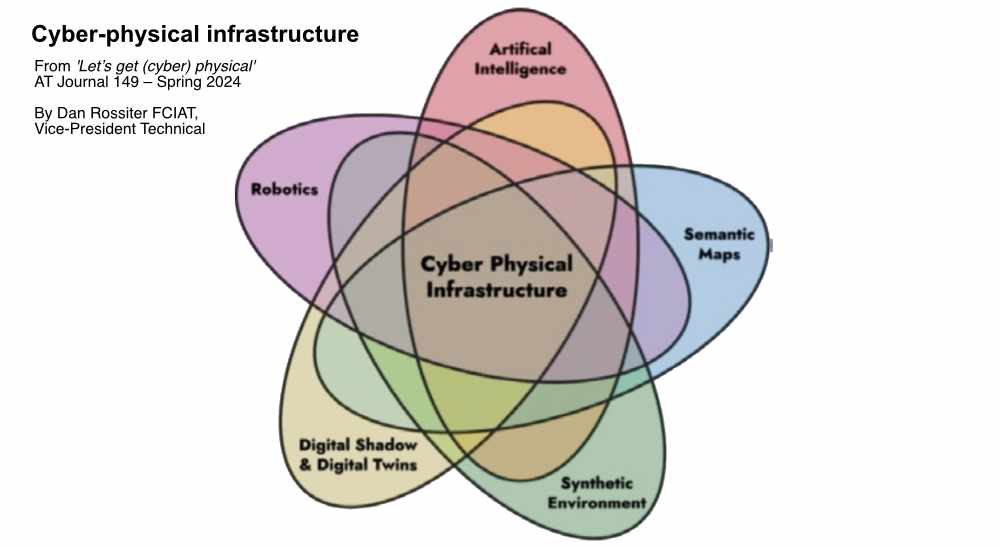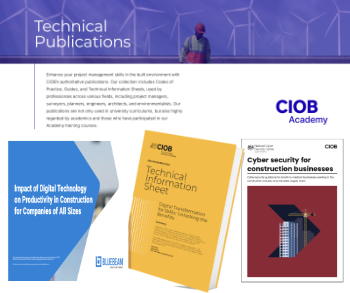Getting cyber-physical
Contents |
[edit] What has been going on?
Back in 2022, the Department for Science, Innovation, and Technology (DSIT) alongside the Department for Business and Trade (DBT) published a consultation on the Government’s vision for enabling cyber-physical infrastructure. A new term for many, cyber-physical infrastructure encapsulates concepts which connect the physical and digital domain; such as digital twins, internet of things, artificial intelligence and robotics. See cool diagram above.
Following a wealth of input, a consultation response document was published outlining several key enablers to realise a society empowered by cyber physical infrastructure, these being:
- Security and resilience: in particular how to overcome risk aversion and enable trust as part of data-driven decision making;
- Interoperability: in the wider sense, including interoperability of expectations and ethics;
- Recognised value proposition: considering that a significant proportion of potential value lies in interconnection between datasets;
- Frameworks, guidance and standardisation: fundamental enablers and catalysts for adoption; and
- Skills: ensuring society has the capability to establish, maintain and utilize such infrastructure.
The report also helpfully includes case studies which cut across key sectors such as energy, transport and the built environment. Among these case studies is work undertaken by the various catapults, this work is also helpfully summarised by Simon Hart on the UKRI website. In further support of realising cyber-physical infrastructure, Innovate UK also commissioned Responsive Infrastructure (The Fenby-Taylor Review). Henry, the author, has written about this report in more detail elsewhere. However, I thought it was worth highlight several of its recommendations below, including:
- Increasing the visibility and viability of innovators;
- addressing the skills gap;
- more tailored access to relevant research; and
- creating the opportunity to develop and test ideas within safe environments.
Finally, the several catapults have joined forces to explore how to best establish a cyber-physical system innovation ecosystem.
[edit] How can I engage?
Clearly there are a plethora of activities underway. So, what are some of the best ways to engage with this work?
[edit] National cyber-physical infrastructure
If you are interested in the work being undertaken by the catapults to realise an innovation ecosystem, it is probably best to read Responsive Infrastructure (The Fenby-Taylor Review) and join the Digital Twin Hub. Several updates relating to NCPI have already appeared on the Hub.
[edit] Digital Twins
again, an ideal place to engage would be the Digital Twin Hub. If you are interested in the National Digital Twin programme specifically, they have recently created their own NDTp gov.uk site, which is currently populated with case studies. Alternatively, if you are of a more disruptive mindset, you may enjoy engaging with the Digital Twin Fan Club and their podcast series. Finally, keep an eye out on the BSI website for the upcoming publication of BS ISO 30172 (digital twin use case) and BS ISO 30173 (digital twin concepts and terminology).
[edit] Information Management and BIM
a foundational concept, information management and BIM continues to gain momentum both nationally and globally. One of the best ways to engage with the topic is through Nima as well as the UK BIM Framework website.
[edit] Artificial Intelligence
if you are interested in standards (who is not?), then Alan Turing’s AI Standards Hub, is an ideal forum for you to engage with as well as our national standards committee for artificial intelligence ART/1. Alternatively, if you are an innovator, in particular a small business, you may be interested in the Innovate UK BridgeAI programme which offers funding and support to help innovators assess and implement AI.
Whilst digital has been gaining momentum since the advent of computers, it had been doing so in a disjointed manner. The introduction of cyber-physical infrastructure has, helpfully, begun to bring these concepts under a single holistic framework. I am hopeful that this will not only catalyse our journey to a more digital built environment, but also reduce frictions as we explore innovations beyond BIM.
This article appears in the AT Journal issue 149, Spring 2024 as "From 'Let’s get (cyber) physical' " written by Dan Rossiter FCIAT, Vice-President Technical.
--CIAT
[edit] Related articles on Designing Buildings
- CIAT articles.
- Cyber hygiene
- Cyber-physical system.
- Cyber resilience
- Cyber security
- Cyber security and engineering
- Cyber-security and phishing
- Cyber security specialist
- Cyber threats to building automation and control systems
- ECA cyber security policy template
- Infrastructure and cyber attacks
- Mitigating online risk with Cyber Essentials security
- National Cyber Security Centre
- UK organisations encouraged to review cyber security in response to situation in and around Ukraine
Featured articles and news
50th Golden anniversary ECA Edmundson apprentice award
Deadline for submissions Friday 30 May 2025.
The benefits of precast, off-site foundation systems
Top ten benefits of this notable innovation.
Encouraging individuals to take action saving water at home, work, and in their communities.
Takes a community to support mental health and wellbeing
The why of becoming a Mental Health Instructor explained.
Mental health awareness week 13-18 May
The theme is communities, they can provide a sense of belonging, safety, support in hard times, and a sense purpose.
Mental health support on the rise but workers still struggling
CIOB Understanding Mental Health in the Built Environment 2025 shows.
Design and construction material libraries
Material, sample, product or detail libraries a key component of any architectural design practice.
Construction Products Reform Green Paper and Consultation
Still time to respond as consultation closes on 21 May 2025.
Resilient façade systems for smog reduction in Shanghai
A technical approach using computer simulation and analysis of solar radiation, wind patterns, and ventilation.
Digital technology, transformation and cybersecurity
Supporting SMEs through Digitalisation in Construction.
Villa Wolf in Gubin, history and reconstruction. Book review.
Construction contract awards down one billion pounds
Decline over the past two months compared to the same period last year, follows the positive start to the year.
Editor's broadbrush view on forms of electrical heating in context.
The pace of heating change; BSRIA market intelligence
Electric Dreams, Boiler Realities.
New President of ECA announced
Ruth Devine MBE becomes the 112th President of the Electrical Contractors Association.
New CIAT Professional Standards Competency Framework
Supercedes the 2019 Professional Standards Framework from 1 May 2025.
Difficult Sites: Architecture Against the Odds
Free exhibition at the RIBA Architecture Gallery until 31 May.
PPN 021: Payment Spot Checks in Public Sub-Contracts
Published following consultation and influence from ECA.


























